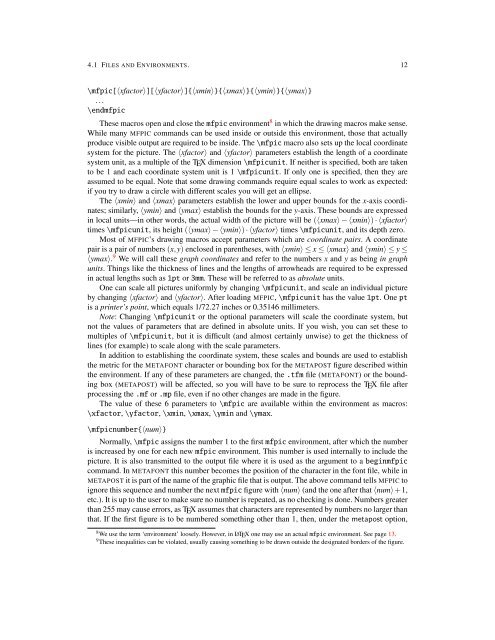Create successful ePaper yourself
Turn your PDF publications into a flip-book with our unique Google optimized e-Paper software.
4.1 FILES AND ENVIRONMENTS. 12<br />
\<strong>mfpic</strong>[〈xfactor〉][〈yfactor〉]{〈xmin〉}{〈xmax〉}{〈ymin〉}{〈ymax〉}<br />
...<br />
\end<strong>mfpic</strong><br />
These macros open and close the <strong>mfpic</strong> environment 8 in which the drawing macros make sense.<br />
While many MFPIC commands can be used inside or outside this environment, those that actually<br />
produce visible output are required to be inside. The \<strong>mfpic</strong> macro also sets up the local coordinate<br />
system for the picture. The 〈xfactor〉 and 〈yfactor〉 parameters establish the length of a coordinate<br />
system unit, as a multiple of the TEX dimension \<strong>mfpic</strong>unit. If neither is specified, both are taken<br />
to be 1 and each coordinate system unit is 1 \<strong>mfpic</strong>unit. If only one is specified, then they are<br />
assumed to be equal. Note that some drawing commands require equal scales to work as expected:<br />
if you try to draw a circle with different scales you will get an ellipse.<br />
The 〈xmin〉 and 〈xmax〉 parameters establish the lower and upper bounds for the x-axis coordinates;<br />
similarly, 〈ymin〉 and 〈ymax〉 establish the bounds for the y-axis. These bounds are expressed<br />
in local units—in other words, the actual width of the picture will be (〈xmax〉 − 〈xmin〉) · 〈xfactor〉<br />
times \<strong>mfpic</strong>unit, its height (〈ymax〉 − 〈ymin〉) · 〈yfactor〉 times \<strong>mfpic</strong>unit, and its depth zero.<br />
Most of MFPIC’s drawing macros accept parameters which are coordinate pairs. A coordinate<br />
pair is a pair of numbers (x,y) enclosed in parentheses, with 〈xmin〉 ≤ x ≤ 〈xmax〉 and 〈ymin〉 ≤ y ≤<br />
〈ymax〉. 9 We will call these graph coordinates and refer to the numbers x and y as being in graph<br />
units. Things like the thickness of lines and the lengths of arrowheads are required to be expressed<br />
in actual lengths such as 1pt or 3mm. These will be referred to as absolute units.<br />
One can scale all pictures uniformly by changing \<strong>mfpic</strong>unit, and scale an individual picture<br />
by changing 〈xfactor〉 and 〈yfactor〉. After loading MFPIC, \<strong>mfpic</strong>unit has the value 1pt. One pt<br />
is a printer’s point, which equals 1/72.27 inches or 0.35146 millimeters.<br />
Note: Changing \<strong>mfpic</strong>unit or the optional parameters will scale the coordinate system, but<br />
not the values of parameters that are defined in absolute units. If you wish, you can set these to<br />
multiples of \<strong>mfpic</strong>unit, but it is difficult (and almost certainly unwise) to get the thickness of<br />
lines (for example) to scale along with the scale parameters.<br />
In addition to establishing the coordinate system, these scales and bounds are used to establish<br />
the metric for the METAFONT character or bounding box for the METAPOST figure described within<br />
the environment. If any of these parameters are changed, the .tfm file (METAFONT) or the bounding<br />
box (METAPOST) will be affected, so you will have to be sure to reprocess the TEX file after<br />
processing the .mf or .mp file, even if no other changes are made in the figure.<br />
The value of these 6 parameters to \<strong>mfpic</strong> are available within the environment as macros:<br />
\xfactor, \yfactor, \xmin, \xmax, \ymin and \ymax.<br />
\<strong>mfpic</strong>number{〈num〉}<br />
Normally, \<strong>mfpic</strong> assigns the number 1 to the first <strong>mfpic</strong> environment, after which the number<br />
is increased by one for each new <strong>mfpic</strong> environment. This number is used internally to include the<br />
picture. It is also transmitted to the output file where it is used as the argument to a begin<strong>mfpic</strong><br />
command. In METAFONT this number becomes the position of the character in the font file, while in<br />
METAPOST it is part of the name of the graphic file that is output. The above command tells MFPIC to<br />
ignore this sequence and number the next <strong>mfpic</strong> figure with 〈num〉 (and the one after that 〈num〉+1,<br />
etc.). It is up to the user to make sure no number is repeated, as no checking is done. Numbers greater<br />
than 255 may cause errors, as TEX assumes that characters are represented by numbers no larger than<br />
that. If the first figure is to be numbered something other than 1, then, under the metapost option,<br />
8 We use the term ‘environment’ loosely. However, in LATEX one may use an actual <strong>mfpic</strong> environment. See page 13.<br />
9 These inequalities can be violated, usually causing something to be drawn outside the designated borders of the figure.

















